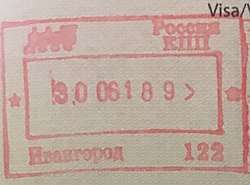Estonia–Russia border
The Estonia–Russia border is the international border between Republic of Estonia (EU member) and the Russian Federation (CIS member). The border is 294 kilometres (183 mi) long. In its present form, it has not changed since 1945, when Estonia became part of the Soviet Union. A small change, which would give a slight increase to Estonia's territory, was to take place in 2014, but neither Russia nor Estonia have completed the ratification of this change.[1]

History

Much of the border with Estonia is water, passing through the channel of the Narva River and Lake Peipsi, but in the south there is a land border, parts of which were disputed when Estonia joined the European Union and NATO. The agreement on the border between the two countries, recognizing that some territories are now in Russia, in the Pechory area of the Pskov Oblast and in the Leningrad Oblast, was signed in May 2005 and ratified by the Estonian parliament, but then Russia withdrew its signature from the treaty.[2] Russia and Estonia afterward signed a border treaty on 17 February 2014, making Estonia the last Baltic country to formalize its border with Russia.[3] As of January 2020, the treaty has not been ratified in either of the countries.[4]
The border towns of Narva (Estonia) and Ivangorod (Russia) are directly adjacent to each other. Both have a predominantly Russian-speaking population.
A border oddity was the road from Värska to Ulitina in Estonia, traditionally the only road to the Ulitina area, which goes through Russian territory for one kilometre of its length, an area called Saatse Boot. This road has no border control, but there is no connection to any other road in Russia. It is not permitted to stop or walk along the road. This border oddity will disappear after the 2014 agreement is implemented when the road will be in Estonia.[1]
Noteworthy is the sharp change in the direction of commerce before and after the establishment of the border. At the beginning of the 1990s, Russian consumers drove to Estonia to purchase goods, while it is now Estonian consumers who buy goods in Russia and often resell goods in Estonia. Top commodities include sugar, cigarettes, and gasoline. Two types of checkpoints operate on the border: auto-pedestrian on Friendship Bridge (Narva — Ivangorod) and on Lake Peipus (since 2004), that exports sand to Estonia for construction.
In August 2015, Estonia decided to build a fence along the border. It will be 110 kilometres (68 mi) long and not be built at lakes or swamps.[5]
Border crossings
Crossing the border is allowed only at border controls. Most people need a visa on one or both sides of the border. Listed from north:[6]
- Road E20 / 1 / M11 between Narva and Ivangorod
- Tallinn-Narva-St. Petersburg railway, at Narva
- Local road in Narva
- Road 106 at Saatse
- Valga-Pechory railway, at Koidula, freight only
- Road 63 at Koidula
- Road E77 / 7 / A212 between Luhamaa and Pskov
Furthermore, the small Estonian road from Värska to Ulitina crosses the border into Russia and goes back to Estonia. There is no border control and it is not allowed to stop or go further into Russia this way.
Since 2011, virtual queuing and remote registration is required for all vehicles crossing the border from Estonia to Russia. www.estonianborder.eu.
See also
- Foreign relations of Russia#Territorial disputes
- Petseri County
- Treaty of Tartu Tartu Peace Treaty — (current boundary agreement in 1920 — reintroduction in 1991 after the Soviet occupation)
- Territorial issues between Estonia and Russia
- The Bridge (Russian TV series)
References
- "Estonia, Russia to exchange 128.6 hectares of land under border treaty". Postimees. 2013-05-28. Retrieved 11 March 2014.
- Россия отозвала подписи под договорами о границе с Эстонией
- "Russia Finally Signs Border Treaty With Estonia". Associated Press. 18 February 2014. Retrieved 19 February 2014.
- "Парламент Эстонии назвал личным мнением слова спикера о границе с Россией". РБК. Retrieved 2020-01-14.
- Estonia to build fence along Russian border (Yahoo News, 27 August 2015)
- Official Journal of the European Union, document 2014/C 420/09